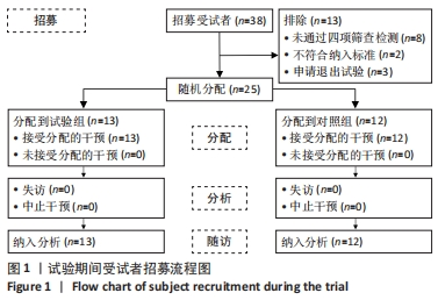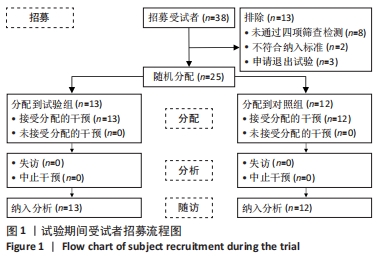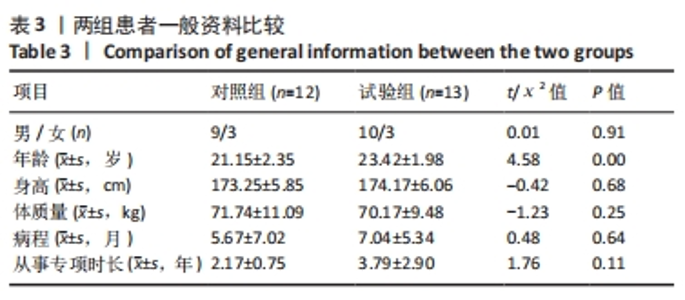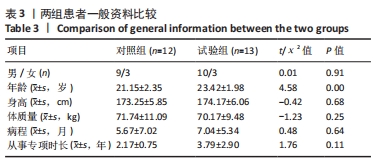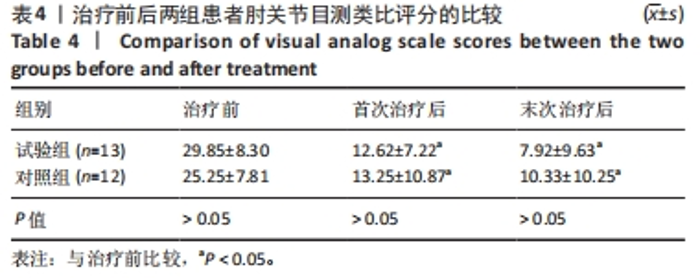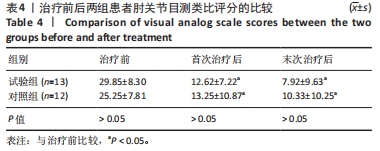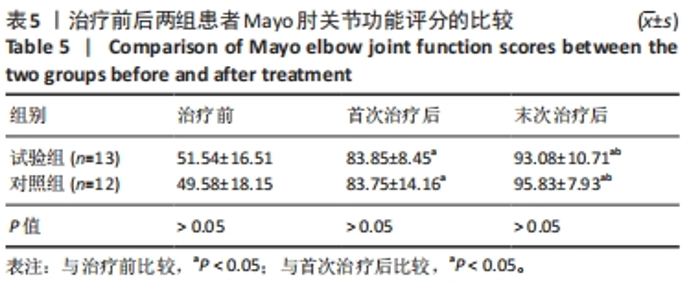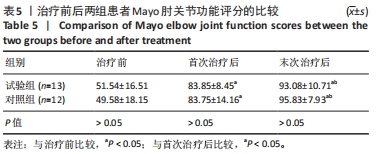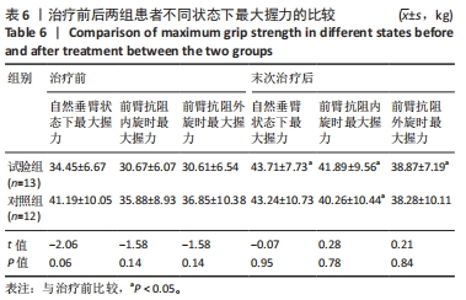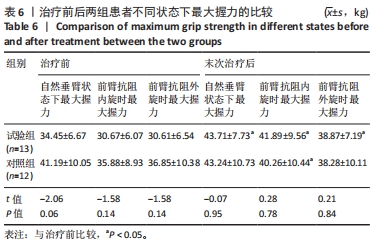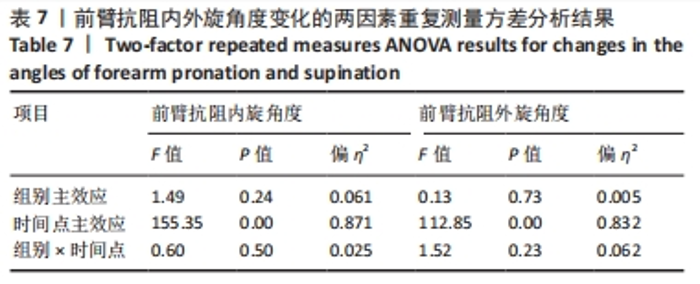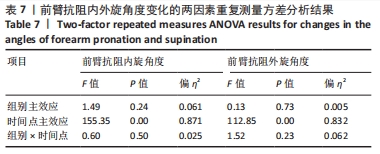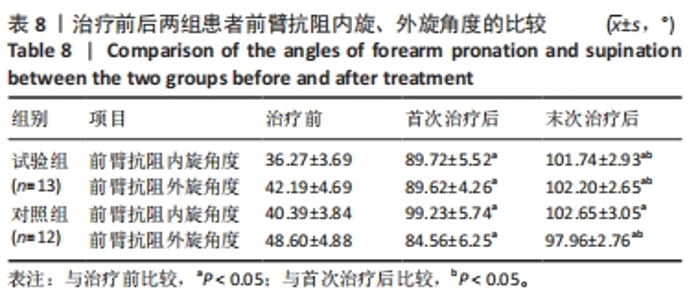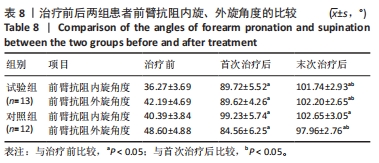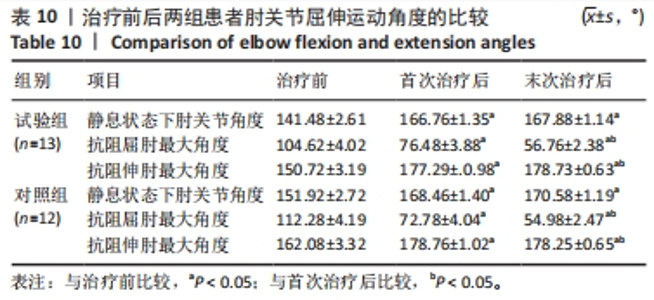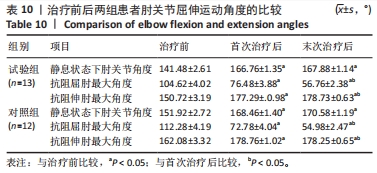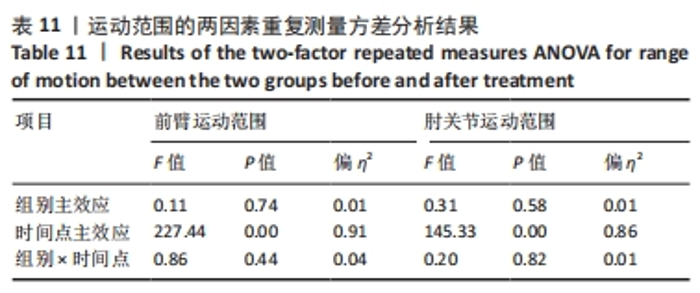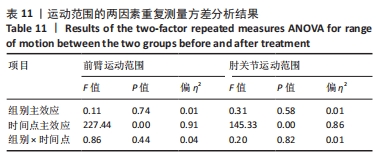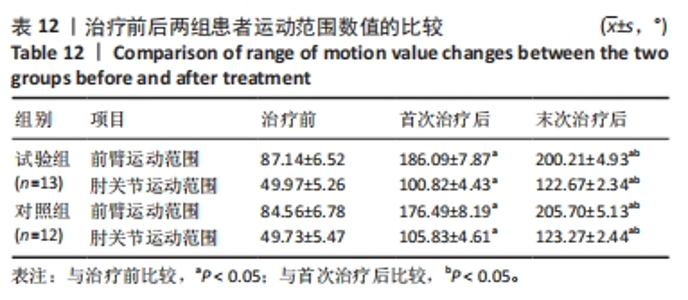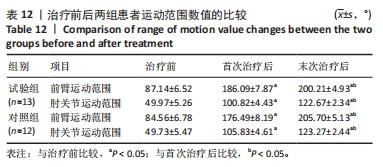Chinese Journal of Tissue Engineering Research ›› 2024, Vol. 28 ›› Issue (26): 4226-4233.doi: 10.12307/2024.437
Previous Articles Next Articles
Therapeutic efficacy of massage versus instrument-assisted soft tissue mobilization in patients with lateral epicondylitis of the humerus
Liu Yang1, 2, Wu Lianqing2, 3
- 1Graduate School, 2School of Arts (China Fitness and Bodybuilding Institute), 3Department of Weightlifting, Wrestling and Flexibility, Wuhan Sports University, Wuhan 430079, Hubei Province, China
-
Received:2023-05-04Accepted:2023-08-04Online:2024-09-18Published:2023-10-07 -
Contact:Wu Lianqing, Master, Professor, School of Arts (China Fitness and Bodybuilding Institute), Wuhan Sports University, Wuhan 430079, Hubei Province, China; Department of Weightlifting, Wrestling and Flexibility, Wuhan Sports University, Wuhan 430079, Hubei Province, China -
About author:Liu Yang, Master candidate, Graduate School, Wuhan Sports University, Wuhan 430079, Hubei Province, China; School of Arts (China Fitness and Bodybuilding Institute), Wuhan Sports University, Wuhan 430079, Hubei Province, China
CLC Number:
Cite this article
Liu Yang, Wu Lianqing. Therapeutic efficacy of massage versus instrument-assisted soft tissue mobilization in patients with lateral epicondylitis of the humerus[J]. Chinese Journal of Tissue Engineering Research, 2024, 28(26): 4226-4233.
share this article
Add to citation manager EndNote|Reference Manager|ProCite|BibTeX|RefWorks
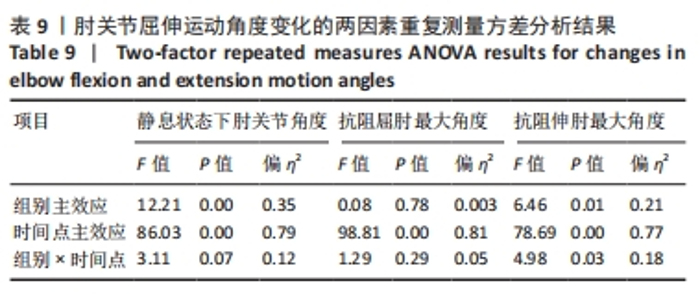
2.7.2 两组患者肘关节屈伸角度的比较 重复测量方差分析结果显示,组别对静息状态下肘关节角度、抗阻伸肘最大角度具有显著影响(F=12.21,P=0.00;F=6.46,P=0.01),对抗阻屈肘最大角度的影响不显著(F=0.08,P=0.78);时间点对静息状态下肘关节角度、抗阻屈肘最大角度、抗阻伸肘最大角度具有显著影响(F=86.03,P=0.00;F=98.81,P=0.00;F=78.69,P=0.00);组别与时间点对静息状态下肘关节角度、抗阻屈肘最大角度的影响不存在交互作用(F=3.11,P=0.07;F=1.29,P=0.29),对抗阻伸肘最大角度的影响存在交互作用(F=4.98,P=0.03),见表9。"
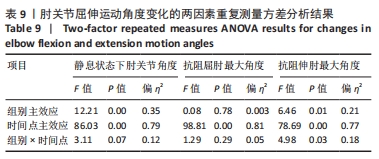

2.8 不良事件 在整个治疗过程中,两组受试者均未出现严重不良反应,但是试验组部分患者IASTM治疗后会出现肘关节局部的皮肤淤青或出现红痧现象,不过并无明显疼痛或不适,两三天内即可恢复。推拿治疗后无任何不良反应。 2.9 随访结果 随访的4-12周内,试验组13例患者中有1例男性在专项训练后和起床静息状态下肘关节偶尔出现中度疼痛,1例女性患者在起床静息状态下偶尔出现轻度疼痛。对照组12例患者在2-4周内有2例男性在专项训练时偶尔出现轻度疼痛;在4-12周内2例男性在专项训练时和专项训练后经常出现轻度疼痛,1例男性在专项训练时、专项训练后、起床静态下经常出现中度疼痛。结果显示,IASTM治疗在短中期改善疼痛疗效方面明显强于推拿治疗。 对照组患者随访2周时有1例男性患者肘关节偶尔疼痛,为轻度疼痛;随访4周时有1例男性患者肘关节偶尔疼痛,为轻度疼痛;随访12周时有3例男性患者肘关节经常疼痛,其中2例为轻度疼痛,1例为中度疼痛。试验组患者随访12周时有1例男性与1例女性患者肘关节偶尔疼痛,分别为中度疼痛与轻度疼痛。"

| [1] EYGENDAAL D, RAHUSSEN FT, DIERCKS RL. Biomechanics of the elbow joint in tennis players and relation to pathology. Br J Sports Med. 2007; 41(11):820-823. [2] LEE HS, PARK HY, YOON JO, et al. Musicians’ medicine: musculoskeletal problems in string players. Clin Orthop Surg. 2013;5(3):155-160. [3] DEGEN RM, CONTI MS, CAMP CL, et al. Epidemiology and DiseaseBurden of Lateral Epicondylitis in the USA: Analysis of 85,318 Patients. HSS J. 2018;14(1):9-14. [4] BISSET LM, VICENZINO B. Physiotherapy management of lateral epicondylalgia. J Physiother. 2015;61(4):174-181. [5] TAYLOR SA, HANNAFIN JA. Evaluation and management of elbow tendinopathy. Sports Health. 2012;4(5):384-393. [6] WALZ DM, NEWMAN JS, KONIN GP, et al. Epicondylitis: pathogenesis, imaging, and treatment. Radiographics. 2010;30(1):167-184. [7] ABEN A, DE WILDE L, HOLLEVOET N, et al. Tennis elbow: associated psychological factors. J Shoulder Elbow Surg. 2018;27(3):387-392. [8] WEBER C, THAI V, NEUHEUSER K, et al. Efficacy of physical therapy for the treatment of lateral epicondylitis: a meta-analysis. BMC Musculoskelet Disord. 2015;16:223. [9] VULPIANI MC, NUSCA SM, VETRANO M, et al. Extracorporeal shock wave therapy vs cryoultrasound therapy in the treatment of chronic lateral epicondylitis. One year follow up study. Muscles Ligaments Tendons J. 2015;5(3):167-174. [10] ALTAY T, GUNAL I, OZTURK H. Local injection treatment for lateral epicondylitis. Clin Orthop Relat Res. 2002;(398):127-130. [11] BODEN AL, SCOTT MT, DALWADI PP, et al. Platelet-rich plasma versus Tenex in the treatment of medial and lateral epicondylitis. J Shoulder Elbow Surg. 2019;28(1):112-119. [12] HUBBARD MJ, HILDEBRAND BA, BATTAFARANO MM, et al. Common Soft Tissue Musculoskeletal Pain Disorders. Prim Care. 2018;45(2):289-303. [13] SUAREZ-RODRIGUEZ V, FEDE C, PIRRI C, et al. Fascial Innervation: A Systematic Review of the Literature. Int J Mol Sci. 2022;23(10):5674. [14] KONDRUP F, GAUDREAULT N, VENNE G. The deep fascia and its role in chronic pain and pathological conditions: A review. Clin Anat. 2022; 35(5):649-659. [15] WEISS K, KALICHMAN L. Deep fascia as a potential source of pain: A narrative review. J Bodyw Mov Ther. 2021;28:82-86. [16] PAVAN PG, STECCO A, STERN R, et al. Painful connections: densification versus fibrosis of fascia. Curr Pain Headache Rep. 2014;18(8):441. [17] STECCO A, MENEGHINI A, STERN R, et al. Ultrasonography in myofascial neck pain: randomized clinical trial for diagnosis and follow-up. Surg Radiol Anat. 2014;36(3):243-253. [18] BITRA M, SUDHAN SG. Instrument Assisted Soft Tissue Mobil-isationinthe Management of Musculoskeletal Pain:A Literature Review with Implications for Clinical Practice Guidelines. J Clin Land Diagn Res. 2019;13(12):1-5. [19] 谭燕泉,吴淑梅,高辉.温针联合推拿治疗肱骨外上髁炎43例效果观察[J].山东医药,2016,56(44):100-101. [20] 陈香仙,朱国萍.肱骨外上髁炎的推拿与抗阻运动康复研究[J].北京体育大学学报,2011,34(6):71-74. [21] SEFFRIN CB, CATTANO NM, REED MA, et al. Instrument-Assisted Soft Tissue Mobilization: A Systematic Review and Effect-Size Analysis. J Athl Train. 2019;54(7):808-821. [22] JONES ER, FINLEY MA, FRUTH SJ, et al. Instrument-Assisted Soft-Tissue Mobilization for the Management of Chronic Plantar Heel Pain: A Pilot Study. J Am Podiatr Med Assoc. 2019;109(3):193-200. [23] KIM J, SUNG DJ, LEE J. Therapeutic effectiveness of instrument-assisted soft tissue mobilization for soft tissue injury: mechanisms and practical application. J Exerc Rehabil. 2017;13(1):12-22. [24] 周鑫,朱清广,孔令军,等.推拿手法生物力学研究方法的基本方向[J].中华中医药杂志,2019,34(3):1120-1123. [25] 严晓慧,严隽陶.推拿手法分类探讨[J].中医报,2017,32(2):300-303. [26] 王建珠,吴云川,杨小存,等.基于教材建设的“推拿”一词出处探讨[J].中医药导报,2022,28(11):219-221. [27] LEW J, KIM J, NAIR P. Comparison of dry needling and trigger point manual therapy in patients with neck and upper back myofascial pain syndrome: a systematic review and meta-analysis. J Man Manip Ther. 2021;29(3):136-146. [28] 徐传英,李伟,叶涛,等.三步推拿法结合功能锻炼治疗腰肌劳损远期疗效观察[J].按摩与康复医学,2020,11(3):26-27+30. [29] 尹航,董博,康武林,等.肱骨外上髁炎中西医治疗进展[J].辽宁中医药大学报,2022,24(3):132-136. [30] MCCALLUM SD, PAOLONI JA, MURRELL GA. Five-year prospective comparison study of topical glyceryl trinitrate treatment of chronic lateral epicondylosis at the elbow. Br J Sports Med. 2011;45(5):416-420. [31] HSU SH, MOEN TC, LEVINE WN, et al. Physical examination of the athlete’s elbow. Am J Sports Med. 2012;40(3):699-708. [32] GARDNER RC. Tennis elbow: diagnosis, pathology and treatment. Nine severe cases treated by a new reconstructive operation. Clin Orthop Relat Res. 1970;72:248-253. [33] ZWERUS EL, SOMFORD MP, MAISSAN F, et al. Physical examination of the elbow, what is the evidence? A systematic literature review. Br J Sports Med. 2018;52(19):1253-1260. [34] 古来撒尔•艾克拜尔,卢旭昇,刘俊昌,等.基于数据挖掘的推拿治疗膝骨关节炎手法及选穴规律分析[J].中国中医药信息杂志, 2022,29(5):23-29. [35] DORF ER, CHHABRA AB, GOLISH SR, et al. Effect of elbow position on grip strength in the evaluation of lateral epicondylitis. J Hand Surg Am. 2007;32(6):882-886. [36] 单洁玲,朱俞岚,阮婷婷,等.剪切波弹性成像在辅助软组织松解术后跟腱功能评估中的应用[J].中国康复理论与实践,2021,27(9): 1098-1103. [37] KIVLAN BR, CARCIA CR, CLEMENTE FR, et al. The effect of Astym® therapy on muscle strength: a blinded, randomized, clinically controlled trial.BMC Musculoskelet Disord. 2015;16(1):325. [38] SEVIER TL, STEGINK-JANSEN CW. Astym treatment vs. eccentric exercise for lateral elbow tendinopathy: a randomized controlled clinical trial. PeerJ. 2015;3:e967. [39] 卢淑卿,李鑫,郭津,等.器具辅助松解技术修复慢性软组织损伤瘢痕的优势[J].中国组织工程研究,2020,24(29):4709-4716. [40] 宋朋飞,朱清广,程艳彬,等.浅谈临床推拿治疗中需要注意的几点事项[J].中华中医药杂志,2017,32(7):2882-2884. [41] 王立红,杨才德,包金莲,等.杨氏3A+疗法“枕五针”埋线针刀治疗枕大神经及枕小神经痛[C].甘肃省针灸学会.甘肃省针灸学会2016年度学术年会暨针灸推拿科研思路设计培训班郑氏针法的临床应用培训班论文集,2016:177-181. [42] 赵春海,罗大平,许荣根,等.疗养因子及传统治疗手段的应用与疗养目的之实施[C].中国康复医学会疗养康复专业委员会, 2008:76-80. [43] ALNASER MZ, ALJADI SH. Physical therapists with work-related musculoskeletal disorders in the state of Kuwait: a comparison across countries and health care professions. Work. 2019;63(2):261-268. [44] RAHIMI F, KAZEMI K, ZAHEDNEJAD S, et al. prevalence of work-related musculoskeletal disorders in iranian physical therapists: a cross-sectional study. J Manipulative Physiol Ther. 2018;41(6):503-507. [45] CORNWELL L, DOYLE H, STOHNER M, et al. Work-related musculoskeletal disorders in physical therapists attributable to manual therapy. J Man Manip Ther. 2021;29(2):92-98. [46] GYER G, MICHAEL J, INKLEBARGER J. Occupational hand injuries: a current review of the prevalence and proposed prevention strategies for physical therapists and similar healthcare professionals. J Integr Med. 2018;16(2):84-89. [47] BAE YH. Relationships between presenteeism and work-related musculoskeletal disorders among physical therapists in the Republic of Korea. Int J Occup Saf Ergon. 2018;24(3):487-492. [48] CELIK D, MUTLU EK. Clinical implication of latent myofascial trigger point. Curr Pain Headache Rep. 2013;17(8):353. [49] SCHILDER A, HOHEISEL U, MAGERL W, et al. Sensory findings after stimulation of the thoracolumbar fascia with hypertonic saline suggest its contribution to low back pain. Pain. 2014;155(2):222-231. [50] TESARZ J, HOHEISEL U, WIEDENHÖFER B, et al. Sensory innervation of the thoracolumbar fascia in rats and humans. Neuroscience. 2011; 194:302-308. [51] STECCO C, STERN R, PORZIONATO A, et al. Hyaluronan within fascia in the etiology of myofascial pain. Surg Radiol Anat. 2011;33(10):891-896. [52] STECCO A, COWMAN M, PIRRI N, et al. Densification: Hyaluronan Aggregation in Different Human Organs. Bioengineering (Basel). 2022; 9(4):159. [53] FIDUT-WROŃSKA J, CHOŁUJ K, CHMIEL J, et al. Observation using thermography of post-operative reaction after fascial manipulation. Ann Agric Environ Med. 2019;26(3):468-471. [54] FOUSEKIS K, VARDA C, MANDALIDIS D, et al. Effects of instrument-assisted soft-tissue mobilization at three different application angles on hamstring surface thermal responses. J Phys Ther Sci. 2020;32(8):506-509. [55] PIANESE L, BORDONI B. The Use of Instrument-Assisted Soft-Tissue Mobilization for Manual Medicine: Aiding Hand Health in Clinical Practice. Cureus. 2022;14(8):e28623. |
| [1] | Wang Yue, Zhang Yuhan, Wang Jiayi, Huang Yuanxin, Wo Chunxin, Wang Caixia, Zhou Peiran, Wang Lin. Effects of silver needle-thermal conduction therapy on skeletal muscle mitochondria and silent information regulator homolog 3 expression in a rat model of myofascial pain syndrome [J]. Chinese Journal of Tissue Engineering Research, 2024, 28(14): 2202-2208. |
| [2] | Meng Meng, Hu Guanyu, Wu Xingquan, Cong Deyu. Effects of skeletal muscle massage on skeletal muscle function and conversion of skeletal muscle fiber types in type 2 diabetic rats [J]. Chinese Journal of Tissue Engineering Research, 2023, 27(35): 5628-5633. |
| [3] | Liu Baijie, Zhou Honghai, He Xinyu, Qin Hongtu, Chen Longhao, Tian Junming, Lu Qingwang. Three-dimensional finite element method to analyze biomechanical characteristics of spinal manipulation [J]. Chinese Journal of Tissue Engineering Research, 2023, 27(27): 4385-4392. |
| [4] | Lü Qianyi, Chen Xinyi, Zheng Huie, He Haolong, Li Qilong, Chen Chutao, Tian Haomei. Stress and displacement of normal lumbar vertebra and posterior structure with different elbow pressing methods [J]. Chinese Journal of Tissue Engineering Research, 2022, 26(9): 1346-1350. |
| [5] | Zheng Pei, Xing Xinyang, Huo Hongfeng. Exercises for activating foot valgus muscle: reciprocal inhibitory effects on antagonistic muscle elasticity, tension and hardness [J]. Chinese Journal of Tissue Engineering Research, 2022, 26(8): 1149-1153. |
| [6] | Kong Yamin, Yan Juntao, Ma Bingxiang, Li Huawei. Massage vibration intervenes with MyoD expression and proliferation and differentiation of muscle satellite cells in rats with sciatic nerve injury [J]. Chinese Journal of Tissue Engineering Research, 2022, 26(8): 1160-1166. |
| [7] | Wang Tiegang, Pan Lina, Wang Hai, Yang Tiansong, Sun Zhongren. Therapeutic effect of Rod Tuina combined with electrical stimulation biofeedback on stress urinary incontinence in adult women: changes in surface electromyography values of pelvic floor muscles [J]. Chinese Journal of Tissue Engineering Research, 2022, 26(35): 5693-5699. |
| [8] | Xu Hui, Kang Bingxin, Gao Chenxin, Zhao Chi, Xu Xirui, Sun Songtao, Xie Jun, Xiao Lianbo, Shi Qi. Effectiveness of Tuina in the treatment of pain after total knee arthroplasty in patients with knee osteoarthritis [J]. Chinese Journal of Tissue Engineering Research, 2021, 25(18): 2840-2845. |
| [9] | Yin Yuhui, Zhan Jiawen, Wang Shangquan, Shao Chenchen, Zhou Liang. Meta-analysis of acupuncture combined with massage in the treatment of knee osteoarthritis [J]. Chinese Journal of Tissue Engineering Research, 2021, 25(17): 2719-2726. |
| [10] | Zhang Chongfeng, Li Xianlin, Peng Weibing, Jia Hongsheng, Cai Lei. Treating lumbar disc herniation of blood stasis type with Chinese herbs, acupuncture, moxibustion, and massage: a Bayesian network Meta-analysis [J]. Chinese Journal of Tissue Engineering Research, 2021, 25(17): 2781-2788. |
| [11] | Lu Shuqing, Li Xin, Guo Jin, Liu Shiyu, Yang Shunbo, Feng Yuxia, Pang Wei. Advantages in instrument-assisted soft tissue mobilization for chronic soft tissue injury [J]. Chinese Journal of Tissue Engineering Research, 2020, 24(29): 4709-4716. |
| [12] | Wang Yu, Lei Jianyin, Xin Hao, Luo Lin, Li Zhiqiang. Finite element analysis of cervical spine (C2-C7) with degenerated disc under normal loading and massage [J]. Chinese Journal of Tissue Engineering Research, 2020, 24(27): 4278-4284. |
| [13] | He Jianwei, Zhang Junmei, Zhang Ying, Xu Jian, Yang Xiaoling. Changes in pain rating index, visual analogue score, and present pain intensity after far-infrared ceramic microsphere intervention for the treatment of muscle injury [J]. Chinese Journal of Tissue Engineering Research, 2020, 24(16): 2561-2566. |
| [14] | You Tian, Zhang Honglei, Bai Lu, Zhang Xintao, Jiang Xiaocheng, Wang Shuang, Zhang Wentao. Massage effect on transforming growth factor beta1 signaling pathway in a rabbit model of gluteal muscle contracture [J]. Chinese Journal of Tissue Engineering Research, 2020, 24(11): 1683-1688. |
| [15] | Huang Fan, Zhao Siyi, Di Anqi, Yang Yunying, Zeng Haiting, Wen Junmao, Fan Zhiyong, Guo Rusong, Wu Shan. Massage therapy on lumbar disc herniation performed by radar plot: an overview of systematic reviews [J]. Chinese Journal of Tissue Engineering Research, 2019, 23(20): 3195-3200. |
| Viewed | ||||||
|
Full text |
|
|||||
|
Abstract |
|
|||||
